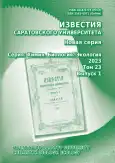Cвободно-радикальная привитая сополимеризация акриламида, 2-акриламидо-2-метилпропансульфоната натрия и хитозана
- Авторы: Обшицер А.С.1, Байбурдов Т.А.2, Шмаков С.Л.2
-
Учреждения:
- ООО «Саратовский химический завод акриловых полимеров «АКРИПОЛ»
- Саратовский национальный исследовательский государственный университет имени Н. Г. Чернышевского
- Выпуск: Том 23, № 1 (2023)
- Страницы: 18-27
- Раздел: Статьи
- URL: https://journals.rcsi.science/1816-9775/article/view/251997
- DOI: https://doi.org/10.18500/1816-9775-2023-23-1-18-27
- EDN: https://elibrary.ru/HMXNJC
- ID: 251997
Цитировать
Полный текст
Аннотация
Об авторах
Артур Самирович Обшицер
ООО «Саратовский химический завод акриловых полимеров «АКРИПОЛ»г. Саратов, пл. Советско-Чехословацкой дружбы
Тельман Андреевич Байбурдов
Саратовский национальный исследовательский государственный университет имени Н. Г. Чернышевскогог.Саратов, ул. Астраханская, 83
Сергей Львович Шмаков
Саратовский национальный исследовательский государственный университет имени Н. Г. Чернышевскогог.Саратов, ул. Астраханская, 83
Список литературы
- Besra L., Sengupta D. K., Roy S. K., Ay P. Studies on fl occulation and dewatering of kaolin suspensions by anionic polyacrylamide fl occulant in the presence of some surfactants // Intern. J. of Mineral Processing. 2002. Vol. 66. P. 1–28. https://doi.org/10.1016/s0301-7516(01)00081-3
- НечаевА. И., ЛебедеваИ. И., ВальциферВ. А., Стрельников В. Н. Исследование влияния состава тройного сополимера акриламида, нитрила акриловой кислоты и 2-акриламидо-2-метилпропансульфоновой кислоты на его устойчивость к термосолевой агрессии // Журнал прикладной химии. 2016. Т. 89, № 8. С. 1047–1053. https://doi.org/10.1134/S1070427216080139
- Куренков В. Ф., Утикеева А. Р. Влияние ионной силы на сополимеризацию акриламида с натриевой солью 2-акриламидо-2-метилпропансульфокислоты в водных растворах // Высокомолекулярные соединения. Серия А. 2000. Т. 42, № 4. С. 587–593.
- Мочалова А. Е., Заборщикова Н. В., Князев А. А., Смирнова Л. А., Извозчикова В. А., Медведева В. В., Семчиков Ю. Д. Привитая полимеризация акриламида на хитозан: структура и свойства сополимеров // Высокомолекулярные соединения. Серия А. 2006. Т. 48, № 9. С. 1588–1594. https://doi.org/10.1134/S0965545X06090069
- Баранов И. А., Андриянова Н. А., Мочалова А. Е., Сибиркин А. А., Батенькин М. А., Смирнова Л. А. Привитая полимеризация акрилонитрила и метилакрилата на хитозан в присутствии комплексов кобальта III // Высокомолекулярные соединения. Серия Б. 2012. Т. 54, № 3. С. 498–505. https://doi.org/10.1134/s1560090412030013
- Abdel-Razik E. S. A., Badawy D. S., El Nahas E. A. Graft copolymerization of acrylamide onto corn starch using mohr’s salt/hydrogen peroxide redox system in aqueous media under visible light // Intern. J. Modern Organic Chemistry. 2015. Vol. 4. P. 1–17.
- Байбурдов Т. А., Шиповская А. Б. Синтез, химические и физико-химические свойства полимеров акриламида: учебное пособие. Саратов : Саратовский источник, 2019. 94 с. 8. Rosa F., Bordado J., Casquilho M. Hydrosoluble copolymers of acrylamide-(2-acrylamido-2-methylpropanesulfonic acid). Synthesis and characterization by spectroscopy and viscometry // J. of Applied Polymer Science. 2003. Vol. 87. P. 192–198. https://doi.org/10.1002/app.11325
- Ullah K., Sohail M., Mannan A., Rashid H., Shah A., Murtaza G., Khan S. A. Facile synthesis of chitosan based-(amps-co-aa) semi-ipns as a potential drug carrier: Enzymatic degradation, cytotoxicity, and preliminary safety evaluation // Curr. Drug Deliv. 2019. Vol. 16. P. 242–253. https://doi.org/10.2174/1567201815666181024152101
Дополнительные файлы










